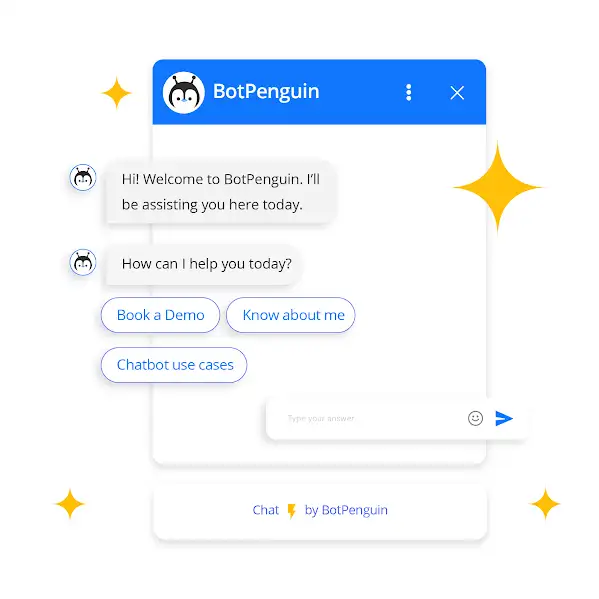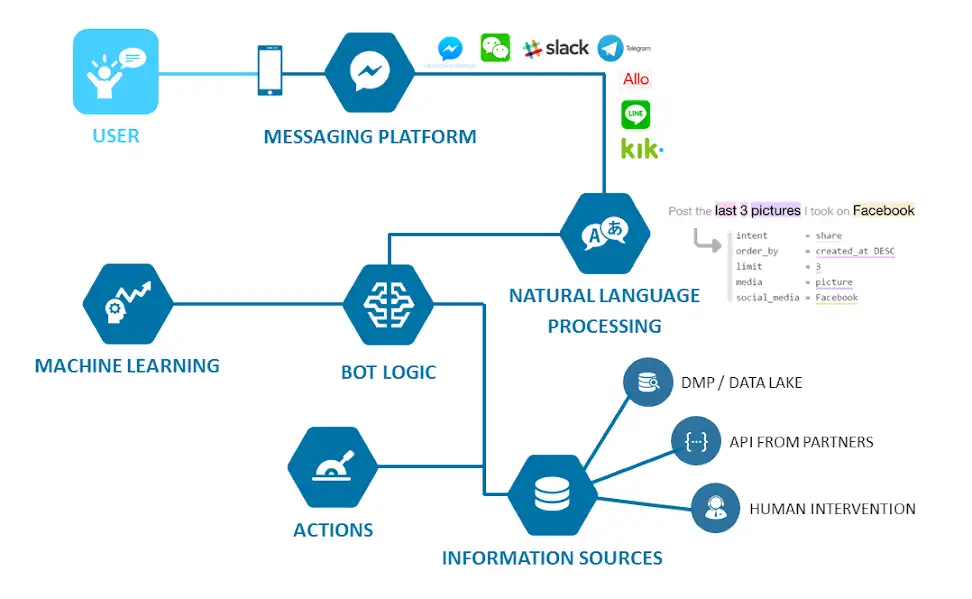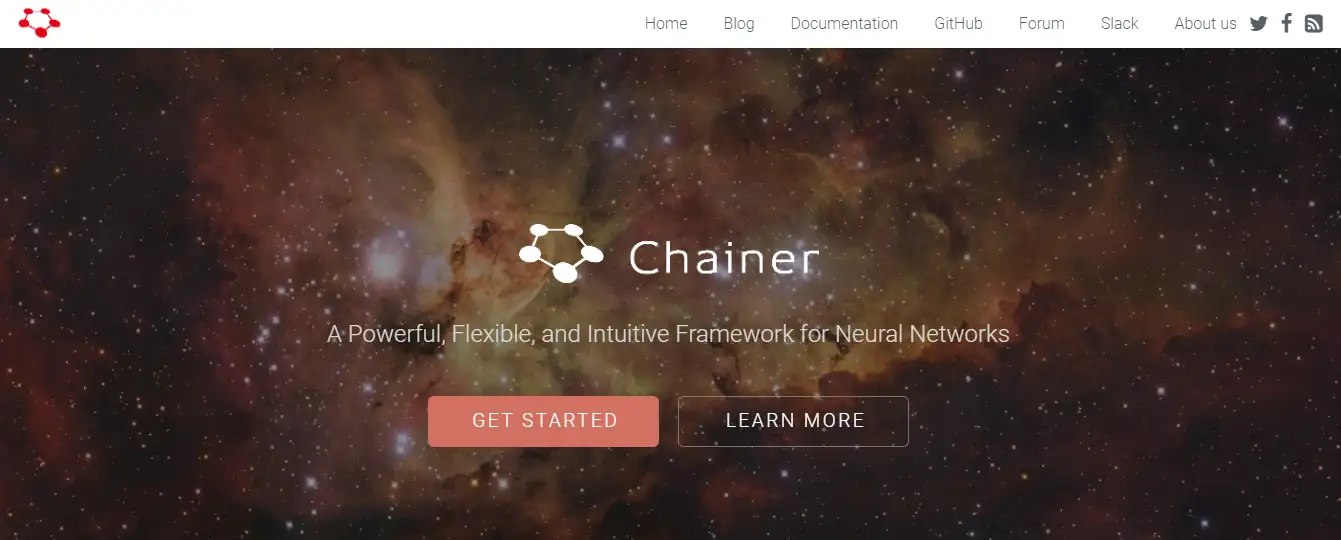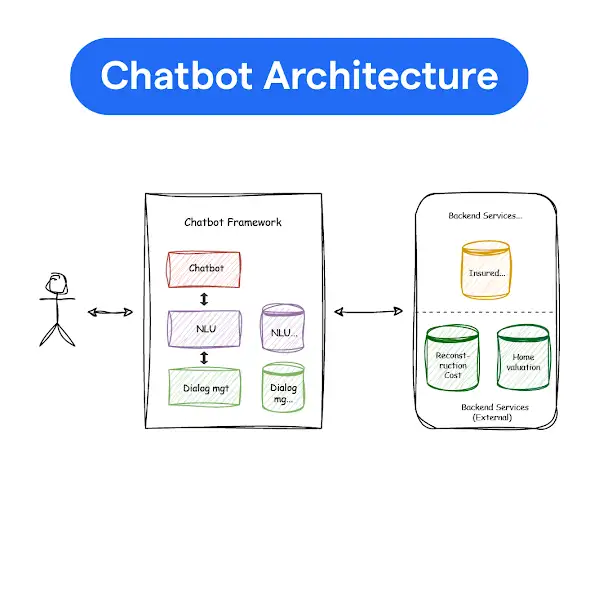Introduction
Ever wondered how those helpful virtual assistants on websites and messaging platforms understand and respond to your queries so effectively? They're called chatbots, and they're smarter than you might think!
Chatbots are AI-powered virtual assistants designed to communicate with users conversationally. They can understand natural language inputs, making interactions more intuitive and seamless.
With applications in customer service, e-commerce, healthcare, and more, chatbots offer 60% 24/7 support, reduce response times by 67%, and enhance user experiences. (Source: MarketandMarketResearch)
Deep learning plays a crucial role in chatbot development. It allows the system to learn from data and improve its responses over time. By leveraging deep learning techniques, developers can create chatbots that understand natural language inputs and provide contextually relevant responses.
Chainer, a user-friendly deep learning framework, simplifies the process of building intelligent chatbots. With its flexible architecture and a wide range of modules, Chainer provides developers with the tools they need to create sophisticated chatbot systems.
In this blog, we'll explore the essential components of a chatbot system, design considerations, and how to build a chatbot dataset. We'll also discuss developing a chatbot model using Chainer, training, fine-tuning it, and evaluating its performance.
Understanding Chatbots: Conversational AI Powering Modern Interactions

Chatbots have become an increasingly familiar sight across various online experiences. These AI-powered virtual assistants are transforming how we interact with businesses, access information, and even navigate complex tasks. But what exactly are chatbots, and how do they work?
Conversational Mimicry: Simulating Human Dialogue
At their core, chatbots are computer programs designed to simulate conversation with human users.
They achieve this by employing natural language processing (NLP) techniques. NLP allows chatbots to understand the intent and meaning behind user queries, even when phrased in an informal or unstructured way.
This enables chatbots to respond in a way that mimics human conversation, fostering a more natural and engaging user experience.
Beyond Simple Scripts: Powered by Machine Learning
Early chatbots relied heavily on pre-programmed scripts and keywords. They could only respond to a limited set of questions and often struggled with variations in language or complex inquiries.
Today's chatbots are far more sophisticated, leveraging the power of machine learning. By analyzing vast amounts of conversation data, these chatbots can learn and adapt over time.
They can identify patterns in user behavior, recognize different conversational styles, and even personalize their responses based on past interactions.
Applications Across Industries: Enhancing User Experiences
Chatbots have found applications in a wide range of industries, each offering unique benefits:
Customer Service: Chatbots, like BotPenguin, can provide 24/7 customer support. It can answer frequently asked questions, resolving basic issues, and even scheduling appointments. This frees up human agents to handle more complex inquiries.
E-commerce: Chatbots can guide customers through the buying process, answer product questions, and offer personalized recommendations. This can lead to increased sales conversions and improved customer satisfaction.
Healthcare: Chatbots can be used for appointment scheduling, symptom checking, and providing basic health information. They can also offer emotional support and mental health resources.
Education: Chatbots can act as virtual tutors, answering student questions, providing feedback on assignments, and offering personalized learning resources.
Entertainment: Chatbots can power interactive games, quizzes, and even personalized storytelling experiences.
Beyond Functionality: The Importance of User Experience
While chatbots offer significant functionality, their effectiveness hinges on user experience (UX). Here are some key considerations for creating an engaging and user-friendly chatbot:
Clarity and Conciseness: Chatbot responses should be clear, concise, and easy to understand. Avoid technical jargon or overly complex language.
Multiple Response Options: When possible, offer users multiple response options to choose from. This can improve user satisfaction and guide the conversation flow.
Informative Error Messages: If a chatbot encounters a question it can't answer, provide informative error messages. Offer suggestions for alternative phrasing or ways to rephrase the question.
Transparency and Trust: Be upfront with users about the chatbot's capabilities. Let them know when they're interacting with a bot and offer an easy way to connect with a human agent if needed.
Next, we will see the role of Deep learning in chatbot development.
Role of Deep Learning in Chatbot Development

Chatbots have become our virtual assistants, but what makes them seem intelligent? Deep learning is the key! These algorithms, inspired by the human brain, analyze massive conversation datasets. This allows chatbots to learn and adapt, unlike their pre-programmed ancestors.
Deep learning empowers chatbots with three key abilities:
Learning from Data
By analyzing past interactions, chatbots can understand user intent and adapt their responses.
Imagine a customer service chatbot learning to identify frustrated users and offering empathetic responses.
Understanding Language
Deep learning tackles the complexities of human language. Chatbots can analyze sentiment, recognize keywords, and understand sentence structure.
This lets them grasp the user's meaning and respond accordingly.
Suggested Reading:
Top 10 Deep Learning Frameworks Alternatives to Chainer
Personalization
Deep learning also unlocks personalization. By remembering user preferences, chatbots can tailor interactions.
A shopping chatbot might recommend clothes based on past purchases, creating a more engaging experience.
Next, we will see how chainer can help in chatbot development.
How Chainer can Help in Chatbot Development

Chainer is a robust Deep Learning framework that simplifies building intelligent chatbots. With its user-friendly interface and flexible architecture, Chainer provides developers with the tools they need to create sophisticated chatbot systems.
Chainer offers a wide range of Deep Learning modules and functionalities that can be leveraged to train chatbot models efficiently and optimize their performance.
Key Points:
The key points to know about the Chainer are the following:
Flexibility: Chainer allows developers to build custom neural network architectures for chatbot development.
Ease of Use: Its intuitive design and comprehensive documentation make it accessible for beginners and experienced developers.
Scalability: Chainer's scalability enables developers to train chatbot models on small and large datasets without compromising performance.
Next, we will see how to design the chatbot architecture.
Making Smart Chatbots Using Chainer's Deep Learning
In this section, you’ll find the right steps to make smart chatbots using Chainer’s Deep learning.
Designing the Chatbot Architecture

Designing the architecture of a chatbot system is a crucial step in its development. A well-designed architecture ensures the chatbot can effectively understand user queries and respond accurately.
Let's explore the essential components of a chatbot system and the key considerations involved in its design, leveraging frameworks like Chainer wherever applicable.
Essential Components of a Chatbot System
A chatbot system typically consists of the following components:
Input Interface: This component receives user inputs, such as text messages or voice commands. It serves as the entry point for interactions with the chatbot.
Natural Language Understanding (NLU): The NLU component, powered by Chainer's Deep Learning capabilities, analyses and interprets user input to extract relevant information.
It leverages tokenization, part-of-speech tagging, and entity recognition to understand the meaning behind user queries.
Dialog Management: The dialog management component, supported by Chainer's flexible architecture, handles the conversation's flow.
It keeps track of the chatbot's previous responses and maintains context to provide coherent and contextually relevant replies.
Response Generation: This component, enhanced by Chainer's Deep Learning modules, generates appropriate responses to user queries.
It uses predefined rules, templates, or machine learning algorithms to craft informative and natural-sounding responses.
Suggested Reading:
Chainer vs PyTorch: Comparing Deep Learning Frameworks
Design Considerations: Data Handling, User Interaction, and Response Generation
When designing the chatbot architecture, it is essential to consider the following aspects:
Data Handling: Effective data handling, facilitated by Chainer's scalable framework, is vital for training chatbot models. It involves storing user queries, responses, and any additional information required for context management.
Structuring the data in a suitable format ensures efficient retrieval and processing during training and inference.
User Interaction: To provide a seamless user experience, the chatbot should have intuitive and user-friendly interaction mechanisms.
Chainer's ease of use can aid in designing a conversational flow that feels natural to the user and incorporating features like buttons and menus to simplify user input.
Response Generation: The response generation process, utilizing Chainer's Deep Learning capabilities, should consider the desired style and tone of the chatbot's responses.
By leveraging machine learning algorithms, the chatbot can generate contextually relevant responses tailored to the user's query.
Next, we will see how to build a chatbot dataset.
Building the Chatbot Dataset
Building a high-quality dataset is a crucial step in training a chatbot model. The dataset is the foundation for the chatbot's learning process and influences its ability to understand and respond accurately to user queries.
Let's explore the steps involved in building the chatbot dataset and techniques for data augmentation and cleaning, utilizing Chainer where applicable.
Collecting and Preprocessing Data for Training the Chatbot
To build a comprehensive dataset, you must collect diverse user queries and corresponding responses.
This can be done by scraping relevant data from various sources, like online forums and customer support logs or by manually creating synthetic conversational data.
Ensuring that the collected data covers all possible user intents to train a robust chatbot model is crucial.
Once the data is collected, preprocessing is necessary to eliminate noise and standardize the dataset.
Chainer's preprocessing capabilities provide efficient data-handling functionalities. This includes removing duplicate entries, correcting spelling errors, and performing text normalization.
Preprocessing techniques like tokenization, lemmatization, and stop-word removal can further refine the data and improve the chatbot's understanding.
If you are the one who likes the no coding chatbot building process, then meet BotPenguin, the home of chatbot solutions. With all the heavy work of chatbot development already done for you, simply use its drag-and-drop feature to build an AI-powered chatbot for platforms like:
Techniques for Data Augmentation and Cleaning
Data augmentation techniques, supported by Chainer's flexibility, can help expand the dataset to improve the chatbot's generalization capabilities. This involves applying transformations like paraphrasing, synonym replacement, or adding noise to create new data sample variations.
Cleaning the dataset involves identifying and removing outliers, irrelevant information, or any inaccuracies that can negatively impact the chatbot's performance.
Chainer's scalable architecture facilitates efficient data cleaning processes. Reviewing and validating the dataset to ensure its quality and coherence is crucial.
Chainer has capabilities in designing the chatbot architecture, handling data effectively, and implementing data preprocessing techniques.
By utilizing these capabilities you can build a robust chatbot system with a diverse and well-structured dataset that enables accurate understanding and responsive user interactions.
Next, we will see how to develop the chatbot model.
Developing the Chatbot Model

In the process of developing a chatbot model, it is crucial to understand the importance of creating a well-structured neural network architecture.
This involves selecting the appropriate modules and functions that can effectively process user inputs and generate accurate responses.
In this section, we will discuss the key aspects of developing a chatbot model using Chainer, a powerful deep learning framework.
Configuring the Neural Network Architecture for Chatbot Training
To build a robust chatbot model, it is essential to configure a suitable neural network architecture that can effectively process and understand user queries.
Using the capabilities of Chainer, a deep learning framework, allows for creating complex neural network structures tailored to the chatbot's requirements.
By designing the architecture with layers for input processing, feature extraction, and response generation, the chatbot can efficiently learn and respond to user interactions.
Exploring Different Chainer Modules and Functions for Model Development
Chainer provides a plethora of modules and functions that can enhance the development of the chatbot model.
Developers can leverage Chainer's flexibility and versatility to streamline the model development process.
They can utilize modules such as layers for building neural network structures, optimizers for training efficiency, and functions for data preprocessing and augmentation.
Chainer's comprehensive documentation and support make it easy to explore and implement various modules and functions to optimize the chatbot model.
Next, we will cover how to train and fine tune the chatbot.
Training and Fine-tuning the Chatbot

Training the chatbot involves feeding it with the dataset and iteratively adjusting the model parameters to improve its performance.
Chainer offers optimization techniques like stochastic gradient descent and adaptive learning rate algorithms to train the chatbot model efficiently.
By fine-tuning the neural network's weights and biases through backpropagation, the chatbot can learn to interpret user queries and generate appropriate responses accurately.
Regular monitoring and evaluation of the training process help identify areas for optimization and improvement.
Next, we will see how to evaluate and testing the chatbot,
Evaluating and Testing the Chatbot
Evaluating the chatbot's performance is necessary to ensure accurate responses and enhance the user experience. Chatbot development frameworks like Rasa offer various metrics to measure a chatbot's effectiveness. These metrics include:
Accuracy: This measures the proportion of correct responses the chatbot delivers.
Precision: This reflects how often the chatbot's response is relevant to the query.
Recall: This indicates how often the chatbot identifies the correct response from its knowledge base.
The F1 score, a harmonic mean of precision and recall, can be a useful metric for evaluating the chatbot's ability to provide relevant responses. It considers both the chatbot's ability to avoid irrelevant answers (precision) and its success in identifying all the correct answers (recall).
Beyond these quantitative metrics, analyzing user feedback is crucial. User testing sessions where real people interact with the chatbot can provide valuable insights into its strengths and weaknesses.
Observing how users navigate conversations, what kind of language they use, and where they encounter difficulties can help identify areas for improvement in the chatbot's design and functionality.
By combining these evaluation methods, chatbot developers can ensure their creation is meeting user needs and delivering a positive user experience.
Conclusion
In conclusion, using Chainer's deep learning capabilities to create smart chatbots is a powerful way to enhance user experiences and streamline various processes.
Chatbots can understand natural language inputs, learn from user interactions, and provide contextually relevant responses. Thus making them valuable tools in customer service, e-commerce, and healthcare industries.
With Chainer's user-friendly interface, flexible architecture, and wide range of deep learning modules, developers can efficiently build sophisticated chatbot systems.
By designing a well-structured chatbot architecture, handling data effectively, and implementing data preprocessing techniques, you can create a robust chatbot system that accurately understands and responds to user queries.
Take advantage of the opportunity to harness the power of deep learning and Chainer to create intelligent chatbots that can transform your business or organization.
Start exploring the possibilities today and discover how chatbots can help you connect with users more meaningfully and efficiently.
Suggested Reading:
Chainer vs TensorFlow: Deciding the Ideal Framework
Frequently Asked Questions (FAQs)
What is Chainer and how is it useful for chatbots?
Chainer is a flexible deep learning framework in Python. It allows building and training models for chatbot tasks like intent recognition and natural language generation.
What are the benefits of using Chainer for chatbots?
Chainer offers modularity and customization for building chatbots. It integrates well with other deep learning libraries and is known for its ease of use.
What kind of deep learning models can be used for chatbots with Chainer?
Recurrent Neural Networks (RNNs) like LSTMs are commonly used with Chainer for chatbots. They excel at handling sequential data like conversation history.
Is there a specific dataset needed to train a chatbot with Chainer?
Public dialogue datasets are available for training chatbots. The choice depends on the desired domain and functionality of the chatbot.
How can I evaluate the performance of a chatbot built with Chainer?
Metrics like BLEU score (measures similarity between generated and reference text) can be used to assess the chatbot's fluency and coherence.
What are some challenges of using Chainer for chatbot development?
Chainer requires some coding expertise compared to more user-friendly chatbot development platforms.
Are there any pre-built chatbot models available using Chainer?
Pre-trained language models like MeCab (Japanese morphological analysis) can be integrated with Chainer for specific chatbot functionalities.
Can Chainer be used to build chatbots for multiple languages?
Chainer can be used with multilingual NLP libraries, making it suitable for developing chatbots that understand and respond in various languages.
What resources are available to learn about building chatbots with Chainer?
Chainer documentation provides tutorials and examples for common deep learning tasks relevant to chatbot development.


